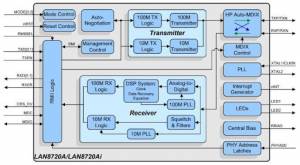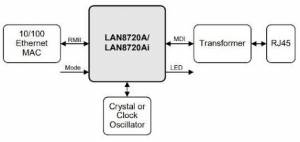General Description
LAN8720A/LAN8720AI is an all-around 10/100Mbps Ethernet physical layer transceiver with small size and low power consumption, which is designed for consumer electronics and enterprise applications. It supports communication with Ethernet Frame through a standard RMII interface. LAN8720A/LAN8720AI can realize the best connection mode (speed and duplex mode) with the destination host through auto-negotiation and supports HP Auto-MDIX automatic flip function, and the connection can be changed to a direct connection or cross-connection without changing the network cable.
According to the IEEE 802.3-2005 standard, the withstand voltage of all digital interface pins is 3.6V. The LAN8720A/LAN8720AI can be configured to run on a single 3.3V power supply using an integrated 3.3V to 1.2V linear regulator. The linear regulator can be selectively disabled, allowing the use of a high-efficiency external regulator to reduce system power consumption. It supports the RMII interface to reduce the number of pins. Besides, it supports full-duplex and half-duplex mode and SMI serial management interface.
LAN8720A/LAN8720AI is suitable for set-top boxes, network printers and servers, test instruments, LAN on motherboards, embedded telecommunications applications, video recording/playback systems, cable modems/routers, DSL modems/routers, digital video recorders, IP and video phones, wireless access points, digital TVs, digital media adapters/servers, game consoles, and POE applications.
Architectural Overview

Pinout Configuration and Description
Pinout configuration

Pinout description
The number of pins of LAN8720A is relatively small, so many pins have multiple functions. Here, we introduce several important settings.
-
PHY chip address setting
The LAN8720A can be configured through the PHYAD0 pin. This pin is multiplexed with the pin RXER. The chip has its pull-down resistor. When the hard reset is completed, the LAN8720A will read the pin level as the device’s SMI address. When connecting a pull-down resistor (floating is also possible, because the chip has a built-in pull-down resistor), set the SMI address to 0, and set it to 1 after an external pull-up resistor. In this chapter, we use this pin to float, that is, set the LAN8720A address to 0.
-
NT/REFCLKO pin function configuration
The nINT/REFCLKO pin can be used as interrupt output or reference clock output. Through the LED2 (nINTSEL) pin configuration, the value of the LED2 pin is read by the LAN8720A after the chip is reset. When the pin is connected to a pull-up resistor (or floating, with a built-in pull-up resistor), then after normal operation, nINT The /REFCLKO pin will be used as an interrupt output pin (select REF-CLK IN mode). When this pin is connected to a pull-down resistor, after the normal operation, the nINT/REFCLKO pin will be used as a reference clock output (select REF-CLK OUT mode).
In the REF-CLK IN mode, an external 50Mhz reference clock must be provided to the XTAL1 (CLKIN) pin of the LAN8720A.
In the REF-CLK OUT mode, the LAN8720A can be connected to a 25Mhz quartz crystal, which is multiplied internally to 50Mhz, and then through the REFCLKO pin, it outputs a 50Mhz reference clock to the MAC controller. In this way, the BOM cost can be reduced.
- 1.2V internal regulator configuration
LAN8720A needs 1.2V voltage to power VDDCR, but the chip integrates a 1.2V voltage regulator. You can configure whether to use the internal voltage regulator through LED1 (REGOFF). When the internal voltage regulator is not used, 1.2V must be provided externally to the VDDCR pin. Here we use the internal voltage regulator, so we connect a pull-down resistor to LED1 (floating is also OK, with a built-in pull-down resistor) to control the opening of the internal 1.2V regulator.
Block Diagram

LAN8720A Application
Smart home system solution based on embedded computer
The smart home system based on an embedded WEB server is composed of an embedded WEB server and a home wireless sensor network. STM32 microcontroller is used as a microcontroller, LAN8720A is used as an Ethernet communication chip, uCOS-Ⅱ is used as an operating system, and LwIP protocol stack is used to build a WEB server, realizing the monitoring of home environment data and the remote control of household appliances. After testing, the system has flexible control methods, fast system response, high stability, and low cost.
System Requirements
The smart home system solution consists of a computer main control management system, a network wiring system, a tablet computer, etc. to achieve centralized control of home equipment, which effectively combines home life such as home intelligent control, information exchange, consumer services, and security monitoring to achieve integration control. The system has high requirements in terms of safety and stability, communication reliability, high efficiency and convenience, intelligent controllability, and convenient operation. Terminals in any place can be remotely controlled and managed by the computer to operate the home system in an efficient and orderly manner.
It has humanized design, realizes intelligent application, and realizes system functions:
Visual intercom function: It is able to identify the visitor through visual call, automatically open the door lock, and automatically alarm when a stranger intrudes;
Home security function: It features high stability and safety and can provide a variety of wear protection, sitting on the bed, you can flexibly remote control all equipment in the home;
Curtain control: bedroom curtains can be automatically closed when the sunlight is strong, to prevent indoor furniture from being damaged due to excessive sunlight, environmental protection, and energy-saving;
Intelligent lighting control: good flexibility, humanized design, centralized control of indoor lighting, wireless remote control, and scene control of lighting;
The appearance design is stylish and beautiful, the interface is friendly, and it is easy to operate.
System solutions
This embedded computer main control platform is used by the system integrator as the main control device of the management center of the smart home system. It adopts a heat-dissipating ice fin structure design, stylish and novel appearance, and good heat dissipation. The fanless system is equipped with an Intel Atom N450/ D410/D510 processor, high performance, safety, and stability; the embedded main control platform has 8 USB, 6 COM and 1 Gigabit Ethernet, 1 Mini-PCIE and 1 PCIEx4, rich interface, convenient for other manufacturers Access to hardware and software equipment; at the same time, it supports VGA, LVDS display output, supports independent dual displays, and has unique advantages in controlling home entertainment systems; the platform has good compatibility, supports 2 SATAⅡ, 1 CF cardholder and 1 optional SSD triple storage mode. The embedded computer main control platform has good safety and stability can guarantee long-term stable operation, simple installation, and convenient operation.
System assessment
This embedded computer is used in the main control platform of the smart home system solution. It has the advantages of low power consumption, good compatibility, intelligence, and humanization, which helps system integrators to create a safe, comfortable, energy-saving, and humanized at a low cost. Smart home solutions.
